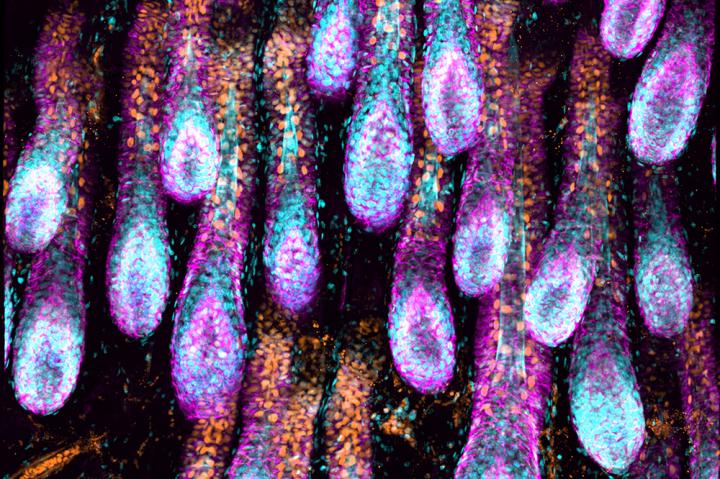Lymphatic system found to play key role in hair regeneration

Growing hair follicles Credit: Robin Chemers Neustein Laboratory of Mammalian Cell Biology and Development at The Rockefeller University Usage Restrictions: Image may only be used to illustrate research described in the accompanying release.
Until now, scientists were uncertain whether the stem cells themselves could instruct other stem cells to form new skin by reshaping their niche. But new research in Science, led by Elaine Fuchs, the Rebecca C. Lancefield Professor, indicates that stem cells can indeed influence tissue regeneration.
The study identifies a molecular coordination tool used by stem cells to signal across niches.
The researchers also discovered a new component of the niche: a specialized type of vessel called lymphatic capillaries, which transport immune cells and drain excess fluids and toxins from tissues.
These capillaries form an intimate network around the stem cell niche within each hair follicle, the study showed, thereby interconnecting all its niches.
“By turning the skin completely transparent,” says postdoctoral fellow Shiri Gur-Cohen, “we were able to reveal the complex architecture of this network of tubes.”
Hair-follicle stem cells control the behavior of lymphatic capillaries by secreting molecules that act as an on-off switch for drainage, the scientists found, enabling them to control the composition of fluids and cells in the surrounding locale and ultimately synchronize regeneration across the tissue.
“The involvement of the lymphatic system in this process is a new concept,” says Fuchs, “and might potentially provide new therapeutic targets for lymph-related conditions such as wound-healing defects and hair loss.”
Media Contact
All latest news from the category: Life Sciences and Chemistry
Articles and reports from the Life Sciences and chemistry area deal with applied and basic research into modern biology, chemistry and human medicine.
Valuable information can be found on a range of life sciences fields including bacteriology, biochemistry, bionics, bioinformatics, biophysics, biotechnology, genetics, geobotany, human biology, marine biology, microbiology, molecular biology, cellular biology, zoology, bioinorganic chemistry, microchemistry and environmental chemistry.
Newest articles

Trotting robots reveal emergence of animal gait transitions
A four-legged robot trained with machine learning by EPFL researchers has learned to avoid falls by spontaneously switching between walking, trotting, and pronking – a milestone for roboticists as well…

Innovation promises to prevent power pole-top fires
Engineers in Australia have found a new way to make power-pole insulators resistant to fire and electrical sparking, promising to prevent dangerous pole-top fires and reduce blackouts. Pole-top fires pose…

Possible alternative to antibiotics produced by bacteria
Antibacterial substance from staphylococci discovered with new mechanism of action against natural competitors. Many bacteria produce substances to gain an advantage over competitors in their highly competitive natural environment. Researchers…





















